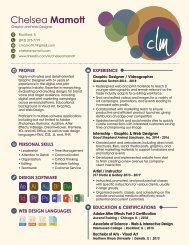Giambattista Bodoni
You also want an ePaper? Increase the reach of your titles
YUMPU automatically turns print PDFs into web optimized ePapers that Google loves.
GIAMBATTISTA<br />
BODONI<br />
The king of typographers and the typographer of kings,<br />
CONSIDER the sheer quality and quanity<br />
one must make to change the course of<br />
typography forever. <strong>Giambattista</strong> <strong>Bodoni</strong><br />
(1740-1813) did just that through his many accomplishments<br />
made during his short life. His<br />
influence on typography stems from a lifelong<br />
journey working as a printer and punchcutter,<br />
having an apprenticeship at the Congregation<br />
for the Propagation of the Faith, gaining the<br />
prestigious role of manager the Royal Press<br />
for the Duke of Parma, producing the Manule<br />
Tipografico, and creating the self- titled font,<br />
<strong>Bodoni</strong>. When <strong>Giambattista</strong> <strong>Bodoni</strong>, was born<br />
into his family of printers in 1740 and in that<br />
moment his fate was placed before him.<br />
EARLY LIFE<br />
On Febuary 16, 1740 <strong>Bodoni</strong> was born in<br />
Saluzzo, Salvoy. <strong>Bodoni</strong> followed in his family’s<br />
footsteps by quickly learning the art of<br />
printing and punchcutting. At the very young<br />
age of eighteen he left home for Rome and<br />
started an apprenticeship at the Congregation<br />
for the Propagation of the Faith (Britannica<br />
Biographies, 2012). During his apprenticeship<br />
<strong>Bodoni</strong> impressed many of his superiors with<br />
his meticulous work and studiousness in mastery<br />
of the ancient languages and type.<br />
This allowed him to complete his first book<br />
based on a version of the Tibetian alphabet<br />
called, Coptic Missal, in 1762 (Famous Graphic<br />
Designers, 2015). This work was so well<br />
done that <strong>Giambattista</strong> <strong>Bodoni</strong> was mentioned<br />
in the colophon.<br />
<strong>Giambattista</strong> <strong>Bodoni</strong>- allposters.com
Then in 1768 <strong>Giambattista</strong> <strong>Bodoni</strong> was invited<br />
by Duke Ferdinando of Bourbon-Parma to organize<br />
a printing house inParma, called la<br />
Stamperia Reale (Zack, 2014) . <strong>Bodoni</strong>’s job<br />
entailed him publicizing the house, and for this<br />
purpose he created specimen books the first<br />
being, Descrizione Delle Feste Celebrate In Parma<br />
L’Anno MDCCLXIX, which was only one in a<br />
long line of books he published (Famous Graphic<br />
Designers, 2015). Soon after, the house began<br />
printing fine editions of classical works such<br />
as Gerusalemme Liberata of<br />
Torquato Tasso and Homer’s literary work.<br />
Because of these publication’s <strong>Bodoni</strong> gained<br />
favor in the public’s eyes, which allowed him to<br />
open his own publication house called Officina<br />
<strong>Bodoni</strong>.<br />
MANUALE<br />
TIPOGRAFICO<br />
While operating his own publishing house <strong>Bodoni</strong><br />
started straying from Old-Style<br />
typefaces with very decorated details and was<br />
won over by the typographical theories of the<br />
French printer, Didot and the English printer,<br />
Baskerville. By 1787 <strong>Bodoni</strong> was printing<br />
typefaces without decoration and started creating<br />
modern typefaces of his own design.<br />
<strong>Bodoni</strong> Punchcuts- metaprintart.info<br />
Manuale Tipografico- luc.devroye.org<br />
Of the many books that he produced during this<br />
period, the best known is his Manuale<br />
tipografico (1788; “Inventory of Types”), a folio<br />
collection of 291 roman and italic typefaces,<br />
along with samples of Russian, Greek, and other<br />
types (Britannica, 2015). He used this manual<br />
to illustrate the four principles of type design:<br />
regularity, clarity, good taste, and charm.<br />
Twenty-seven years later a second edition of<br />
Manuale tipografico was released after an<br />
1840 ‘output inventory’ compiled by <strong>Giambattista</strong><br />
<strong>Bodoni</strong>’s widow that listed 25,491 punches<br />
and more than 50,000 matrices made by the<br />
prolific typographer, printer and punch cutter<br />
(Creative Review, 2013).<br />
TRANSITIONAL TO MODERN<br />
The self-titled typeface, <strong>Bodoni</strong> that we know today was created in 1798. In<br />
order to create this typeface <strong>Giambattista</strong> <strong>Bodoni</strong> made significant changes to<br />
previous letterforms by increasing the stroke contrast, increasing the sharpness<br />
of the serifs, and vertically aligning the axis. These changes were inspired by,<br />
John Baskerville, the first person to introduce typefaces with obvious differences<br />
between thick and thin strokes. These changes lead <strong>Giambattista</strong> <strong>Bodoni</strong> to<br />
stray from the Transitional fonts and create a new Modern font. <strong>Bodoni</strong> accomplished<br />
this by endlessly perfecting his type and always refining. His financial<br />
security provided by the Duke of Parma made this relentless obsession possible<br />
because of this he was able to labor over his letterforms and transcend them<br />
into art (Messmer, 2009).<br />
‘The letters don’t<br />
get their true<br />
delight, when<br />
done in haste &<br />
discomfort, nor<br />
merely done with<br />
diligence & pain,<br />
but first when<br />
they are created<br />
with love and<br />
passion.”<br />
- <strong>Bodoni</strong><br />
azquotes.com
THE TYPEFACE<br />
The typeface, <strong>Bodoni</strong>, separates itself from<br />
transitional fonts because of its high and abrupt<br />
contrasts between thick and thin strokes, its thin<br />
and unbracketed serifs, strong vertical axis, horizontal<br />
stress, and small aperture. These new,<br />
distinct visual characteristics gave rise to the<br />
new classification called Didone or Modern. To<br />
produce these striking qualities <strong>Bodoni</strong> looked<br />
to John Baskerville for visual qualities and to<br />
the new letterform, Roman du Roi for inspiration.<br />
The Roman du Roi letters were designed<br />
based on “scientific principles”, and constructed<br />
through the use of a grid and calculated curves<br />
(Ellsworth). <strong>Giambattista</strong> <strong>Bodoni</strong> employed this<br />
same technique when he went about creating<br />
this letterform, <strong>Bodoni</strong>. These characteristics are<br />
especially noticeable when looking at the unbracketed,<br />
thin serifs. In addition to these characteristics<br />
there a few characteristics that are<br />
uniquely <strong>Bodoni</strong>, which include a square dot<br />
over the “i”, a double story “a”, a capital “Q”<br />
with the tail directly beneath the figure, and a<br />
capital “J” with a slight curve to it (Zack, 2014).<br />
“Plenty of white space and<br />
generous line spacing, and<br />
don’t make the type size too<br />
miserly. Then you will be<br />
assured of a product fit for a<br />
king.”<br />
-<strong>Bodoni</strong><br />
azquotes.com<br />
Current use of <strong>Bodoni</strong>- visualnews.com<br />
THE MAN, THE<br />
FONT, THE KING<br />
Over the years <strong>Bodoni</strong> has been used for a<br />
wide variety of material including 18th century<br />
Italian books to 1960s periodicals. The 20th<br />
century and digital age brought a revival of<br />
<strong>Bodoni</strong>, which lead to the creation of many<br />
versions of <strong>Bodoni</strong> and is still celebrated today.<br />
Currently you can view this work at the <strong>Bodoni</strong><br />
Museum along with his punchcuts and matrices.<br />
<strong>Giambattista</strong> <strong>Bodoni</strong> truly influenced the world<br />
of typography. He lived a very short life that<br />
was full of accomplishments such as an internship<br />
at the Congregation for the Propagation of<br />
the Faith, followed by the esteemed role working<br />
at the Royal Press for the Duke of Parma,<br />
generating the Manule Tipografico, and producing<br />
the self- titled font, <strong>Bodoni</strong>. <strong>Giambattista</strong><br />
<strong>Bodoni</strong> not only marks a transition for Old Style<br />
to Modern type but also the first steps of using<br />
text as an art form.















